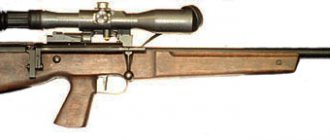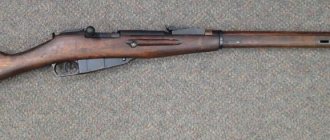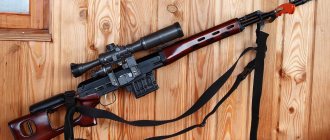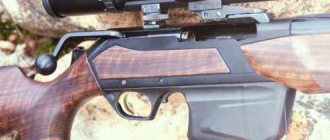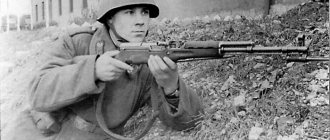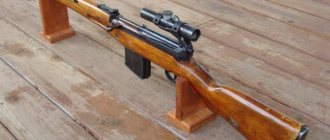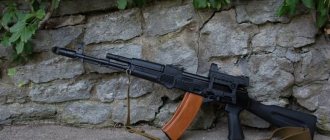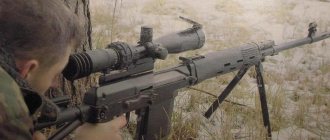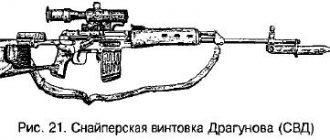Review of the KO-30 S carbine
Model 1891/1930 was a dragoon carbine with a slightly different sight and a simplified chamber. The weapon was used as a combat weapon in cavalry units. After World War II, the weapon became completely obsolete and was mothballed.
However, the resulting shortage of good hunting carbines led to the Mosin rifles being removed from the warehouse and converted into hunting rifles. Moreover, in many cases the carbines were re-barreled to a different caliber. Model KO-30 S is authentic.
Rifles of the 1891/1930 model are of collector's value today.
A review of the KO-30 S rifle is given in that video:
Advantages and disadvantages
The carbines produced on the basis of the Mosin rifle were somewhat different. In the combat version, the bolt handle remained straight and short. In the sniper model, the handle is longer and bent down. This is of fundamental importance: military weapons, especially those released later, by 1944, participated in infantry attacks, that is, they played the role of a bayonet weapon. And such use has an extremely negative effect on the quality of shooting.
The sniper version excludes such use. Accordingly, the model made on the basis of a sniper rifle has much higher ballistic characteristics.
The advantages of the weapon are the following:
- An optical sight is installed on the sniper rifle. There is no such option on a conventional combat carbine;
- on models starting from 1930, cylindrical boxes are installed - in the left side you can see 2 cylindrical holes or traces of their welding. This is also a sign of a sniper, that is, a rifle with good accuracy;
- A remarkable feature of Mosin rifles is the quality of the barrel. This is indicated by a clean barrel finish and old bluing. On new models, the barrel and chamber are chrome-plated;
- The weapon is designed for hunting large animals - wild boar, elk. A shell bullet can easily pierce through the trunk of a brother-in-law with a girth of thickness from a distance of 100 m;
- the bullet's flight range is 3 km;
- The carbine can be used in any weather conditions at temperatures from -50 to +50 C.
The disadvantages of the product are as follows:
- the magazine has to be filled with cartridges “one at a time” in order to prevent the sleeve edge of the upper cartridge from jumping over the edge of the lower one;
- the screws holding the stock to the barrel tend to come loose. The tightening of the screws must be monitored, as this affects the accuracy of shooting;
- The quality of a weapon is highly dependent on previous use. Rifles produced after 1942 are characterized by poor barrel quality and, in principle, are not designed for use as a sniper.
Carbine KO-30S (photo)
Purpose
Model KO-30 S is a medium caliber carbine.
- It is used as a hunting rifle when hunting medium and large animals - wapiti, wild boar, elk.
- It is also used for hunting birds - black grouse and wood grouse.
- The weapon is used extremely rarely for recreational shooting - the caliber is too serious.
Varieties
By rifle KO-30 S, as well as KO 91/30, they mean a combat carbine of the 1891/1930 model converted into a hunting weapon. The difference between the individual modifications is so small that in most cases it is not considered as a separate variety.
- The most famous version is the KO-30 S with an optical sight. Moreover, its placement is such that you can use the open front sight without removing the OP.
- A modification is available, equipped only with an open mechanical sight.
- KO 91/30 M – is equipped with a new forged barrel with chrome plating of both the barrel itself and the chamber. Moreover, 2 models are produced with different barrel lengths: 550 mm with a total length of 1055 mm, and 610 mm with a length of 1115 mm.
KO-30-S S PU – medium-caliber carbine for amateur and professional hunting
The KO-30-S carbine is a “modern edition” of the legend, the immortal Russian 3-line (7.62 mm) Mosin rifle of the 1891/1930 model. The carbine is intended for professional and amateur hunting at ambient temperatures from + 50 °C to -50 °C, for novice athletes, for participants in reconstructions and collectors. The carbine is suitable even for recreational shooting at non-standard targets. But we must remember that this is a serious weapon, designed for hunting large animals - wild boar, elk. A shell bullet can easily pierce a tree trunk with a girth of thickness from a distance of 100 m.
Specifications
The ballistic characteristics of the sniper version of the rifle are quite sufficient to consider this model one of the most reliable and in demand for hunting. However, it is worth remembering that the performance of each specific gun depends on how and for how long it was used.
| Parameter | Meaning |
| Caliber, mm | 7,62 |
| Store capacity, number of pieces | 5 |
| Sighting range, m | 300 |
| Accuracy of fire (dispersion radius) | 75 |
| Shot resource, pcs. | 2000 |
| Weapon weight, kg | 4,0 |
| Weapon length, mm | 1232 (and less) |
| Barrel length, mm | 745 (or less) |
| Initial bullet speed, m/s | 730 |
The weight of the product is given without an optical sight or any other device, but with a loaded magazine.
Barrel length and carbine length may vary depending on the modification.
Design and equipment of the KO-30-S carbine
The shutter is a sliding type with rotation when locked. The hammer is cocked when the handle is turned during the unlocking process. And the trigger rests on the sear when locked. It is possible to cock the firing pin manually with the bolt closed; to do this, you need to pull the trigger back (in this case, the trigger is the tip screwed onto the shank of the firing pin). To engage the safety, the trigger must be pulled back as far as it will go and turned counterclockwise. Sector sight, like on a rifle mod. 1891/30. Consists of an aiming bar with a clamp, an aiming block and a spring. Marked up to a distance of 2,000 meters; a single rear sight can be installed in any position from 50 to 2,000 m, in increments of 50 m. The front sight is located on the barrel near the muzzle. At arr. 1891/30 received a ring ear muff. The rifle's trigger is long, quite tight and without "warning". Wooden stock made of birch. In the sniper model, KO-30-S, the handle is longer and bent down. This model may have an optical sight installed in its base.
Characteristics of KO-30-S
KO-30-S is a heavy carbine with excellent balance, strong recoil, excellent accuracy and firing range.
- The weight of the carbine is no more than 4.3 kg.
- Carbine length – 1232 mm, width – 83 mm, height – 190 mm.
- Barrel length – 729 mm.
- The trigger force is unregulated, ranging from 2.0 to 2.4 kg.
The diameter of bullet dispersion (firing accuracy) at a range of 800 meters is no more than 20 cm. Deviation of the average point of impact (MIP) from the aiming point (firing accuracy) at a range of 400 meters is no more than 8 cm, at a range of 800 meters is no more than 20 cm The operating time until the limit state is reached is 2000 shots. Good ballistics and high power of the cartridge of the KO-30-S carbine, high survivability of the barrel and bolt, optical sight, long sighting range, trouble-free operation of the rifle’s mechanisms in any conditions, simple and reliable bolt design, these are just some of the advantages of this carbine. To purchase a carbine, a license to purchase a hunting weapon with a rifled barrel is required.
Design
The carbine differs from the original in the bolt handle and the presence of an optical sight. The barrel can be authentic or processed. The rest of the structure is no different from the Mosin rifle.
The carbine consists of the following assembly units:
- barrel with receiver - the barrel, the receiver, as well as the sighting block and the front sight base are permanently connected. The barrel bore and chamber are chrome-plated - thus increasing the corrosion resistance of the product;
- bolt assembly - includes a bolt stem, ejector, trigger, striker-type impact device, mainspring, connecting strip. The safety is implemented in the bolt - it prevents a shot from being fired when chambering a cartridge;
- trigger - without warning;
- magazine box with single-row placement of cartridges - integral with the barrel. Capacity – 5 rounds;
- open front sight and optical sight. The latter is fixed on special brackets. To shoot from an open sight there is no need to remove the OP;
- The rifle stock is made of birch.
Design and equipment of the KO-30-S carbine with PU
The shutter is a sliding type with rotation when locked. The hammer is cocked when the handle is turned during the unlocking process. And the trigger rests on the sear when locked. It is possible to cock the firing pin manually with the bolt closed; to do this, you need to pull the trigger back (in this case, the trigger is the tip screwed onto the shank of the firing pin). To engage the safety, the trigger must be pulled back as far as it will go and turned counterclockwise. Sector sight, like on a rifle mod. 1891/30. Consists of an aiming bar with a clamp, an aiming block and a spring. Marked up to a distance of 2,000 meters; a single rear sight can be installed in any position from 50 to 2,000 m, in increments of 50 m. The front sight is located on the barrel near the muzzle. At arr. 1891/30 received a ring ear muff. The rifle's trigger is long, quite tight and without "warning". Wooden stock made of birch. In the sniper model, KO-30-S, the handle is longer and bent down. This model may have an optical sight installed in its base.
Characteristics of KO-30-S with PU
KO-30-S is a heavy carbine with excellent balance, strong recoil, excellent accuracy and firing range.
- The weight of the carbine is no more than 4.3 kg.
- Carbine length – 1232 mm, width – 83 mm, height – 190 mm.
- Barrel length – 729 mm.
- The trigger force is unregulated, ranging from 2.0 to 2.4 kg.
The diameter of bullet dispersion (firing accuracy) at a range of 800 meters is no more than 20 cm. Deviation of the average point of impact (MIP) from the aiming point (firing accuracy) at a range of 400 meters is no more than 8 cm, at a range of 800 meters is no more than 20 cm The operating time until the limit state is reached is 2000 shots. Good ballistics and high power of the cartridge of the KO-30-S carbine, high survivability of the barrel and bolt, optical sight, long sighting range, trouble-free operation of the rifle’s mechanisms in any conditions, simple and reliable bolt design, these are just some of the advantages of this carbine. To purchase a carbine, a license to purchase a hunting weapon with a rifled barrel is required.
Options and packaging
The standard equipment of the carbine includes the following items:
- box;
- ramrod;
- screwdriver;
- breech and muzzle bushing;
- knob;
- wipe and oiler;
- Passport products.
For modification with an optical sight, the following are supplied:
- optical sight – 3.5x, maximum;
- passport for OP.
Mosin rifle - KO91/30
Operating principle
The mechanism of operation of the carbine does not differ from the standard operation scheme of a three-line rifle.
- The shutter is opened by turning the handle to the left. In this case, the trigger is pulled back, and the mainspring is partially compressed - pre-compression. The firing pin goes into the channel of the combat cylinder, the protrusions move upward due to the supporting planes and the barrel channel is unlocked.
- The bolt is pulled back all the way - at the same time the cartridge from the magazine goes to the chambering line.
- The bolt moves forward - the cartridge is in the chamber.
- The handle is turned to the right and the bolt is closed. In this case, the combat protrusions extend beyond the ledges of the box and the barrel is locked. The mainspring is pressed harder - final compression.
- They press the trigger - the sear disengages from the hammer, the hammer is released, the spring straightens and the hammer striker forcefully breaks the cartridge primer - this is how the shot occurs.
- The bolt is pulled back - at the same time, the ejector pulls the cartridge case out of the chamber, and the cut-off reflector throws it out of the receiver.
When storing, carrying and transporting, the carabiner must be set to the “safety” position. In this mode, the combat platoon is placed in the recess of the box. The safety ridge of the trigger rests against the box, which prevents an accidental shot. In fact, in this position you cannot even open the shutter.
A mandatory requirement is to store the rifle unloaded and set to the “safety” position. Ammunition and rifle must be stored separately.
In this video, the barrel and trim marks of the KO 91 30 are inspected with an endoscope:
Disassembly
The weapon is disassembled and reassembled for cleaning and lubrication after firing. In this case, you cannot apply significant force, otherwise the parts may become deformed.
Partial disassembly - for lubrication, includes the following steps:
- press the trigger, open and pull out the shutter;
- unscrew and remove the cleaning rod. Remove the cover of the magazine box;
- holding the combat cylinder and the handle, retract the trigger until a protrusion comes out of the socket on the screw cut. Then turn the trigger to the left and release;
- holding the bolt, move the bar with the combat cylinder forward and disconnect it from the bolt stem;
- the combat larva is separated from the bar;
- the firing pin is put into the gasket, the handle is pressed and the mainspring is compressed. In this position, unscrew the trigger from the firing pin and remove the firing pin with the spring;
- the mainspring is removed from the firing pin.
If the weapon is to be stored for a long time or the carbine is exposed to moisture, the weapon is completely disassembled. In addition to the above steps, the following are added:
- the stop and tail screws are unscrewed 2 turns and the stock rings are moved forward;
- set the carbine in a vertical position, completely unscrew the screws, disconnect the magazine box, and then the barrel from the stock;
- remove the lid latch from the magazine box;
- disassemble the trigger device - to do this, turn the carbine upside down and support it so that the mechanism does not rest against anything. Unscrew the trigger spring screw and push out the trigger axis;
- disconnect the trigger spring from the hook.
The product is assembled in the reverse order. Cleaning and lubrication is carried out no less than 6 hours after shooting.
Product prices
The KO-30 S rifle is valued by hunters and fully lives up to expectations. Its cost, however, is affordable: the price of a carbine ranges from 26,895 to 32,000 rubles. depending on the condition of the barrel and its authenticity.
The following cartridges are offered for the carbine:
- cartridge Extra 7.62*54 – tombak bullet jacket, brass sleeve. Costs 59 rubles. per piece;
- NPZ cartridge - a bullet with a tombak jacket that prevents barrel wear - 98 rubles. per piece;
- noise refinery cartridge with a bimetallic sleeve - 22 rubles;
- cartridge with increased accuracy - tombak bullet casing, bullet weight 9.9 g - 34 rubles;
- S&B cartridge with improved ballistic characteristics, bullet weight 11.3 g - 161 rubles.
Carbine KO-30S 7.62x54R with TOZ launcher
Analogs
- Analogues of the KO-30 S hunting carbine are Russian hunting rifles - “Vepr”, “Tiger”, “Sobol”.
- Foreign ones include the M1 Garand Laminated Stock and especially the Custom 7, 62 x 54 R, created on the basis of the KO91/30M.
- The sniper rifles Remington Varmint SF, Remington 770, Orsis 120, M82, and some others can also boast of good qualities.
The KO-30 S carbine is an improved version of the sniper model of the Mosin three-line rifle. The gun is distinguished by its excellent accuracy of fire, high reliability and availability of ammunition.
The firing MMGs of the Mosin KO-91/30-S carbine and the Mosin KO-91/30-SX rifles are reviewed in this video:
KO-30-S – medium-caliber carbine for amateur and professional hunting
The KO-30-S carbine is a “modern edition” of the legend, the immortal Russian 3-line (7.62 mm) Mosin rifle of the 1891/1930 model. The carbine is intended for professional and amateur hunting at ambient temperatures from + 50 °C to -50 °C, for novice athletes, for participants in reconstructions and collectors. The carbine is suitable even for recreational shooting at non-standard targets. But we must remember that this is a serious weapon, designed for hunting large animals - wild boar, elk. A shell bullet can easily pierce a tree trunk with a girth of thickness from a distance of 100 m.
